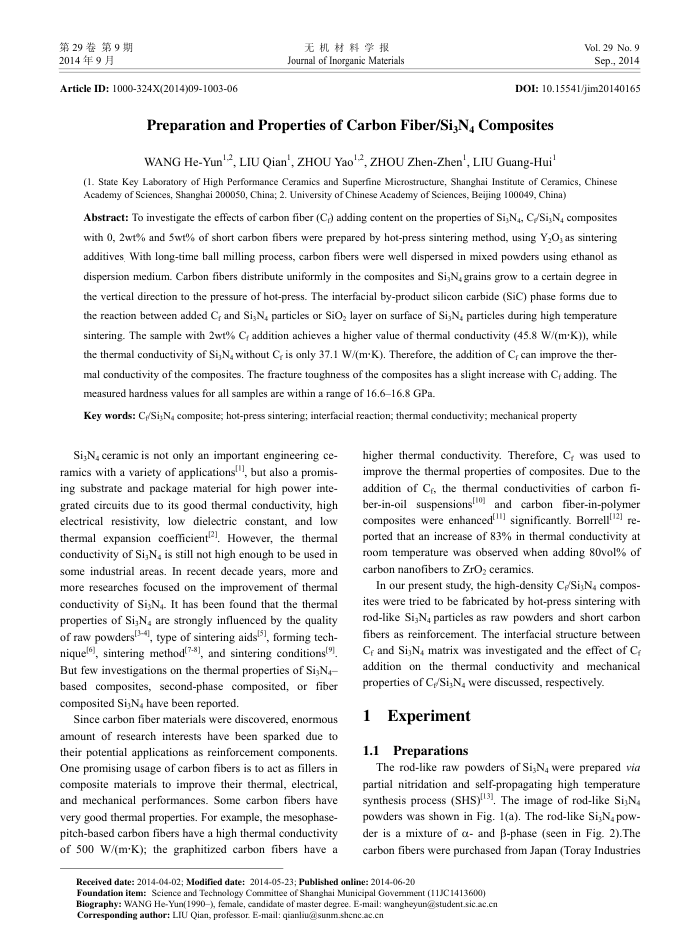碳纤维复合Si3N4陶瓷材料的制备及性能研究
内容简介
 第29卷第9期 2014年9月
第29卷第9期 2014年9月Article ID: 1000-324X(2014)09-1003-06
无机材料学报 Journal of Inorganic Materials
Vol. 29 No. 9 Sep-, 2014
DOI:10.15541/jim20140165
PreparationandPropertiesofCarbonFiber/Si,N,Composites
(1. State Key Laboratory of High Performance Ceramics and Superfine Microstructure, Shanghai Institute of Ceramics, Chinese Academy of Sciences, Shanghai 200050, China; 2. University of Chinese Academy of Sciences, Beijing 100049, China)
Abstract: To investigate the effects of carbon fiber (C) adding content on the properties of Si,N4, C/Si,N, composites with 0, 2wt% and 5wt% of short carbon fibers were prepared by hot-press sintering method, using Y,O; as sintering additives With long-time ball milling process, carbon fibers were well dispersed in mixed powders using ethanol as dispersion medium. Carbon fibers distribute uniformly in the composites and Si,N, grains grow to a certain degree in the vertical direction to the pressure of hot-press. The interfacial by-product silicon carbide (SiC) phase forms due to the reaction between added Cr and Si,Ny particles or SiO, layer on surface of Si,N, particles during high temperature sintering. The sample with 2wt% Cy addition achieves a higher value of thermal conductivity (45.8 W/(m-K), while the thermal conductivity of Si,N, without C, is only 37.1 W/(m-K). Therefore, the addition of C can improve the ther-mal conductivity of the composites. The fracture toughness of the composites has a slight increase with Cr adding. The measured hardness values for all samples are within a range of 16.616.8 GPa.
Key words: C/Si,N composite; hot-press sintering; interfacial reaction; thermal conductivity; mechanical property
Si,N, ceramic is not only an important engineering ce-ramics with a variety of applications'), but also a promis-ing substrate and package material for high power inte-grated circuits due to its good thermal conductivity, high electrical resistivity, low dielectric constant, and low thermal expansion coefficient/2]. However, the thermal conductivity of Si,N, is still not high enough to be used in some industrial areas. In recent decade years, more and more researches focused on the improvement of thermal conductivity of SigN4. It has been found that the thermal properties of Si,N are strongly influenced by the quality of raw powders[-4], type of sintering aids[5], forming tech niquel6], sintering method(7-8), and sintering conditions(9] But few investigations on the thermal properties of Si;N4 based composites, second-phase composited, or fiber composited Si,N, have been reported.
Since carbon fiber materials were discovered, enormous amount of research interests have been sparked due to their potential applications as reinforcement components. One promising usage of carbon fibers is to act as fillers in composite materials to improve their thermal, electrical, and mechanical performances. Some carbon fibers have very good thermal properties. For example, the mesophase-pitch-based carbon fibers have a high thermal conductivity of 500 W/(m·K); the graphitized carbon fibers have a
higher thermal conductivity. Therefore, C, was used to improve the thermal properties of composites. Due to the addition of C, the thermal conductivities of carbon fi-ber-in-oil suspensionslio] and carbon fiber-in-polymer composites were enhanced[1l] significantly. Borrell[12] re ported that an increase of 83% in thermal conductivity at room temperature was observed when adding 80vol% of carbon nanofibers to ZrO2 ceramics.
In our present study, the high-density Cp/Si,N4 compos-ites were tried to be fabricated by hot-press sintering with rod-like SigN4 particles as raw powders and short carbon fibers as reinforcement. The interfacial structure between Cr and Si,N, matrix was investigated and the effect of Cf addition on the thermal conductivity and mechanical properties of Cp/Si,N, were discussed, respectively.
Experiment 1.1Preparations
The rod-like raw powders of SigNy were prepared via partial nitridation and self-propagating high temperature synthesis process (SHS)l13). The image of rod-like Si,N powders was shown in Fig. 1(a). The rod-like Si,Nμ pow-der is a mixture of α- and β-phase (seen in Fig. 2).The carbon fibers were purchased from Japan (Toray Industries
Received date: 2014-04-02; Modified date: 2014-05-23; Published online: 2014-06-20
Foundation item: Science and Technology Committee of Shanghai Municipal Govemment (11JC1413600) Biography: WANG He-Yun(1990), female, candidate of master degree. E-mail: wangheyun@student.sic.ac.cn Corresponding author: LIU Qian, professor. E-mail: qianliu@sunm.shcnc.ac.cn